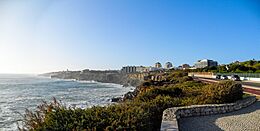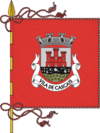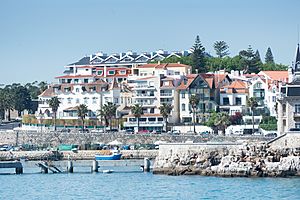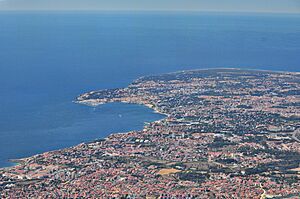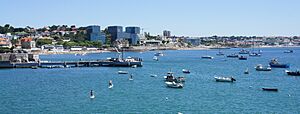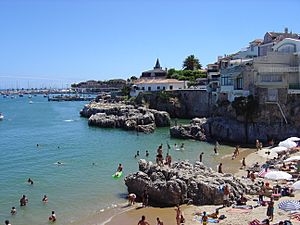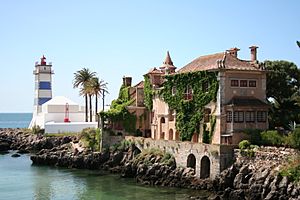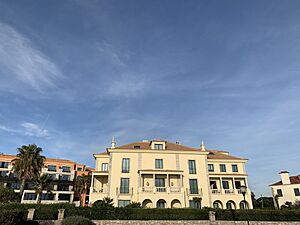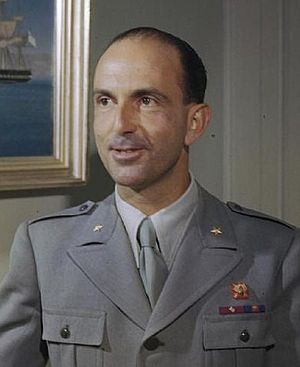Cascais facts for kids
Quick facts for kids
Cascais
|
|||
|---|---|---|---|
|
Municipality
|
|||
|
Clockwise: Along the coast west of Boca do Inferno; Palacete Seixas; King Carlos I Ave.; Praia do Guincho; Marechal Carmona Park; View of Cascais and Estoril.
|
|||
|
|||
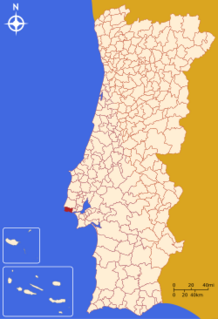 |
|||
| Country | |||
| Region | Lisbon | ||
| Metropolitan area | Lisbon | ||
| District | Lisbon | ||
| Parishes | 4 | ||
| Area | |||
| • Total | 97.40 km2 (37.61 sq mi) | ||
| Population
(2021)
|
|||
| • Total | 214,158 | ||
| • Density | 2,198.75/km2 (5,694.73/sq mi) | ||
| Time zone | WET/WEST (UTC+0/+1) | ||
| Postal code |
2750
|
||
| Area code | 214 | ||
| Patron | Saint Anthony | ||
Cascais (pronounced cash-KYSHE) is a lovely town in Portugal. It is part of the Lisbon District. Cascais is located right on the coast, in an area often called the Portuguese Riviera.
This municipality is home to over 214,000 people. Cascais is a very popular place for tourists. Its marina hosts big events like the America's Cup sailing race. The nearby town of Estoril, which is part of Cascais, also hosts large meetings.
Cascais became a popular seaside resort in the 1870s. This happened when King Luís I of Portugal and the royal family started spending their summers there. Many other important families then built summer homes in the area. Cascais is also famous for being a home for many royal families who were in exile. These included King Edward VIII of the United Kingdom and King Juan Carlos I of Spain. The Casino Estoril even inspired the first James Bond book, Casino Royale.
Today, Cascais is one of the wealthiest areas in Portugal. It has a high cost of living but is known for its great quality of life.
Contents
History of Cascais
People have lived in the Cascais area since the late Paleolithic (Stone Age). We know this from old remains found in places like Talaíde. During the Neolithic period, people started living here permanently. They used natural caves and built shelters to bury their dead. They would bury items with them, a practice that continued into the Copper Age.
The Roman Empire also had a presence here. Evidence includes old Roman farms (called villae) and ten tanks used for salting fish. Roman rule even influenced some local place names. For example, "Caparide" comes from a Latin word for "caper".
Later, the Visigoths lived in the area. Their mark can be seen in the Visigothic Cemetery of Alcoitão. Muslim settlers also left their names on places like "Alcoitão" and "Alcabideche". An 11th-century poet, Ibn Muqana al-Qabdaqi, who wrote about the area's farms, was born in Alcabideche.
Becoming a Town
Cascais really started to grow in the 1100s. At first, it was part of the town of Sintra. Cascais relied on fishing and farming. By the 1200s, its fish even supplied the city of Lisbon. The name "Cascais" likely comes from this time. It means "mountain of shells," referring to all the seashells found on the coast.
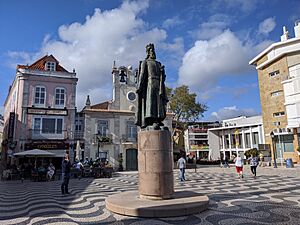
The town became more important and gained independence from Sintra in 1364. On June 7, 1364, King Peter I made Cascais an official town. This meant it could have its own judges and leaders. The town had to pay the King a yearly fee, but it was wealthy enough to do so easily. The land around Cascais was owned by different noble families over time.
The castle of Cascais was probably built around this period. By 1370, King Ferdinand had given the castle to a nobleman. Even though Castilian forces attacked and blocked the port in the late 1300s, Cascais kept growing. By the end of the 14th century, new parishes (local areas) were created.
From Fishing Village to Royal Resort
From the Middle Ages onwards, Cascais depended on fishing. It was also a stop for ships going to Lisbon. Farmers grew wine, olive oil, and cereals. Because it was at the mouth of the Tagus river, it was important for defending Lisbon. Around 1488, King John II built a small fortress by the sea.
In 1514, Manuel I gave Cascais a new charter. This officially set up the town's local government. The main church, the Church of Nossa Senhora da Assunção, dates from the early 1500s. The medieval fortress was not strong enough to stop invaders. In 1580, Spanish troops took over the village. The fortress was made bigger later by King Philip I (who was also Philip II of Spain). He turned it into a strong Renaissance citadel.
In 1755, a huge earthquake in Lisbon destroyed much of Cascais. Later, in 1807, French troops invaded Portugal. The Cascais citadel was taken over by the French army.
A big change came in 1862. A nobleman, the Visconde da Luz, built a summer house in Cascais. He also helped build a road linking Cascais to Lisbon. Because of these improvements, King Luís I decided to make Cascais his summer home. From 1870 to 1908, the Portuguese royal family spent their summers here. This turned the quiet fishing village into a popular, fancy place.
Thanks to King Luís, the citadel got the country's first electric lights in 1878. Cascais also got a better road to Sintra, a bullring, and a sports club. Many rich families built beautiful mansions. The first railway arrived in 1889. In the early 1900s, a casino and other buildings were added in nearby Estoril.
In 1896, King Carlos I loved the sea. He set up the first oceanographic laboratory in Portugal inside the citadel. The King himself led 12 science trips to the coast. These trips ended in 1908 when he was assassinated.
Cascais Today
During World War II, Portugal remained neutral. Because of its beauty and royal history, Cascais became a safe place for many exiled royal families from Europe. Their stories are told at the Exiles Memorial Centre.
Today, Cascais is a very popular vacation spot. People from Portugal and all over the world visit its beautiful beaches. The town hosts many international events, especially for sailing and surfing. In 2018, it was named the European Youth Capital.
Geography and Climate
Cascais is located on the western edge of the Tagus river mouth. It sits between the Sintra mountains and the Atlantic Ocean. To the north is the municipality of Sintra. The ocean is to the south and west. To the east is the municipality of Oeiras.
Local Areas
Administratively, Cascais is divided into 4 main areas called civil parishes (freguesias):
- Alcabideche
- Carcavelos e Parede
- Cascais e Estoril
- São Domingos de Rana
Beaches of Cascais
Cascais has 17 beaches along its coastline. Some of the popular ones include:
- Praia das Avencas
- Praia da Conceição
- Praia da Rainha (Queen's Beach)
- Praia de Carcavelos
- Praia do Guincho
Guincho Beach and Carcavelos Beach are especially famous for surfing, windsurfing, and kitesurfing. This is because of the strong winds and ocean waves there. Near Guincho Beach is the Cresmina Dune. This is a moving sand dune system, always changing due to the wind.
Weather in Cascais
Cascais has a Mediterranean climate. This means it has mild, wet winters and warm, dry summers. The Atlantic Ocean helps keep temperatures from getting too extreme. Temperatures rarely go below 5°C (41°F) or above 30°C (86°F).
Economy and Tourism
It is easy to get to Cascais from Lisbon. You can drive on the A5 highway or take the scenic coastal road. There are also frequent, inexpensive trains. Taxis are also common.
The town has the ruins of a castle. It also has an art museum and an ocean museum. There are beautiful parks and old, cobbled streets in the historic center. Cascais has many hotels and restaurants. It is a great place to stay if you want to visit Lisbon but prefer to be outside the big city.
Cascais is a busy place. It ranks high in Portugal for how many people are employed.
Cascais is surrounded by popular beaches. Guincho Beach is great for surfing due to the winds. The calmer beaches to the east are perfect for sunbathing. The beautiful Sintra mountains to the north are also a big draw. The coastline to the west has cliffs and places like the Boca do Inferno, which offer amazing sea views. Cascais is also becoming a popular place for golf, with over 10 golf courses nearby.
A large marina with 650 places for boats opened in 1999. It has hosted many sailing events. Cascais also hosts international tennis and motorcycling events. For many years, the Estoril race track hosted the F1 Portugal Grand Prix. The Estoril Casino is one of the biggest in Europe. Near the casino is the "Hotel Palácio," where parts of the James Bond movie On Her Majesty's Secret Service were filmed.
In 2017, Cascais started charging a small tourist tax. This is because it has become one of Portugal's most visited places. About 1.2 million tourists stay in the city's hotels each year. The Cascais Aerodrome in Tires is used for small planes and some domestic flights.
Education in Cascais
Cascais has several international schools:
- The Carcavelos area is home to St. Julian's School, a British international school.
- The Estoril area has a campus of the German School of Lisbon.
- Outeiro de Polima, in São Domingos de Rana, houses Saint Dominic's International School.
Culture and Museums
The Gil Vicente theatre opened in 1869. The royal family often attended shows there. The Cascais Experimental Theatre started in 1965 and has put on many plays.
Over the years, Cascais has developed many art galleries and museums. Most of these are in a small area of town, often in parkland. Together, they are known as The Museum Quarter. Many are in large buildings that used to be private homes. Entrance is usually free or costs a small fee.
Art Galleries
- Casa das Histórias Paula Rego. This is a modern museum that shows the paintings of Paula Rego and her husband Victor Willing.
- Cascais Cultural Centre. This colorful building used to be a convent. It now hosts changing art shows and has a small concert hall.
- Cidadela Arts Centre. This is inside the Citadel of Cascais. It gives artists a place to show and sell their work.
Museums
- The Exiles Memorial Centre is a history museum. It tells the stories of refugees and important people who came through Portugal during World War II.
- The Cascais Citadel Palace Museum is inside the Citadel. It was the summer home of the royal family from 1870 to 1908. Later, it was used by Portuguese presidents. It opened as a museum in 2011.
- Condes de Castro Guimarães Museum. This was built as a summer home for a rich family. It became a museum in 1931. It has paintings, furniture, and jewelry.
- Casa de Santa Maria. This house was built for the same person as the Castro Guimarães Museum. It is known for its design and wall tiles.
- Lighthouse museum. This museum is inside the Santa Marta Lighthouse. You can see old lighthouse lenses and sometimes climb the lighthouse.
- Casa Sommer is a beautiful old house turned into a history museum. It also holds the town's old records. It opened in 2016.
- King D. Carlos Sea Museum opened in 1992. It has exhibits about Cascais's history as a fishing village.
- Town museum (Museu da Vila). This museum gives an introduction to the history of Cascais.
Famous People from Cascais
Many interesting people have lived in Cascais:
- Joaquim António Velez Barreiros (1802–1865): A nobleman honored with streets and a park named after him.
- Nadir Afonso (1920–2013): A famous painter known for his geometric art.
- Francisco Pinto Balsemão (born 1937): A former Prime Minister of Portugal.
- Marcelo Rebelo de Sousa (born 1948): The current President of Portugal.
- Ana Gomes (born 1954): A former diplomat and politician.
- Daniela Ruah (born 1983): A Portuguese-American actress, known for NCIS: Los Angeles.
- Ana Gomes Ferreira (born 1987): A singer/songwriter who became popular on YouTube.
Sports Stars
- Paulo Ferreira (born 1979): A former professional footballer.
- António Félix da Costa (born 1991): A racing car driver and Formula E Champion.
- Frederico Morais (born 1992): A professional surfer.
- Teresa Bonvalot (born 1999): A professional surfer and European Junior Champion.
Royalty in Cascais
- King Luís I of Portugal (1838–1889): The King of Portugal who made Cascais his summer home.
- King Carol II of Romania (1893–1953) and Miklós Horthy (1868–1957): Both lived and died in Estoril, Cascais, after leaving their home countries.
- Edward, Duke of Windsor (1894–1972): The former British King, and his wife Wallis, Duchess of Windsor, stayed in Cascais in 1940.
- King Umberto II of Italy (1904–1983): The last King of Italy. He lived the rest of his life in Cascais.
- Prince Juan of Spain, Count of Barcelona (1913–1993): The father of King Juan Carlos I of Spain. He lived in Cascais with his family.
- Juan Carlos I of Spain (born 1938): The future King of Spain spent his childhood in exile in Estoril.
- Tsar Simeon II of Bulgaria (born 1937): He arrived in Cascais with his mother. He later returned to Bulgaria and became Prime Minister.
International Friends
Cascais is "twinned" with many cities around the world. This means they have special friendly relationships.
 Biarritz, France (since 1986)
Biarritz, France (since 1986) Vitória, Brazil (since 1986)
Vitória, Brazil (since 1986) Santana, São Tomé and Príncipe (since 1986)
Santana, São Tomé and Príncipe (since 1986) Atami, Japan (since 1990)
Atami, Japan (since 1990) Wuxi, China (since 1993)
Wuxi, China (since 1993) Sal, Cape Verde (since 1993)
Sal, Cape Verde (since 1993) Gaza City, Palestine (since 2000)
Gaza City, Palestine (since 2000) Guarujá, Brazil (since 2000)
Guarujá, Brazil (since 2000) Xai-Xai, Mozambique (since 2000)
Xai-Xai, Mozambique (since 2000) Sausalito, United States (since 2012)
Sausalito, United States (since 2012) Ungheni, Moldova (since 2012)
Ungheni, Moldova (since 2012) Campinas, Brazil (since 2012)
Campinas, Brazil (since 2012) Sinaia, Romania (since 2018)
Sinaia, Romania (since 2018) Pampilhosa da Serra, Portugal (since 2018)
Pampilhosa da Serra, Portugal (since 2018) Bucha, Ukraine (since 2022)
Bucha, Ukraine (since 2022)
See also
 In Spanish: Cascaes para niños
In Spanish: Cascaes para niños


